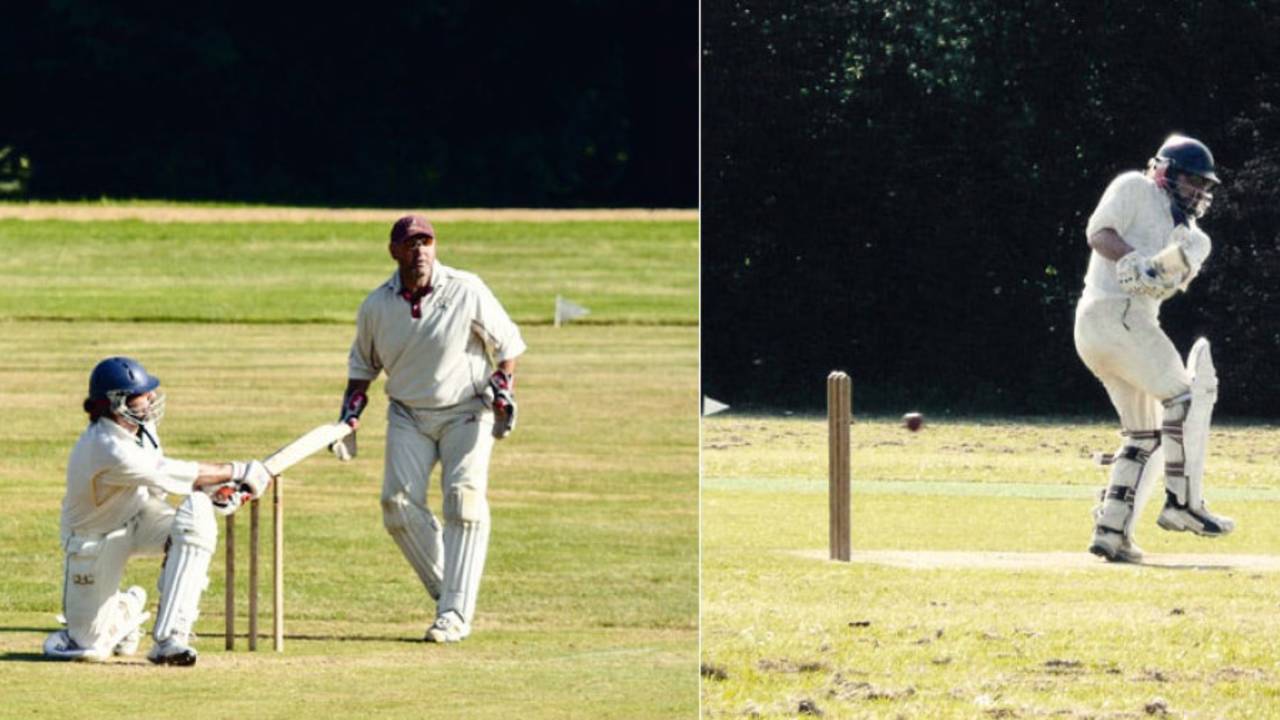What's it like to be an ambidextrous cricketer?
A shoulder injury forced a cricketer to change his batting orientation - and even bat one-handed. He found it wasn't such a bad thing after all
Pete Langman
19-Jun-2015
The writer throws bowlers off course with his versatility • Pete Langman
"Left hand!" cried the wicketkeeper, announcing my orientation to all and sundry. This invoked the usual chorus of groans, jokes, and the Prufrockian coming and going of close fielders and square-leg umpire. Even the cows felt the urge to move. The bowler was dubious: "Since when have you been a lefty, Pete?"
The simple answer is I'm not. I wasn't then, and I never will be. I can, however, bat left-handed. As well as right-handed. And, on those occasions when I'm in long enough to choose, I sometimes switch during an innings. I wasn't born ambidextrous but made myself so after cricket's strange sinistralism was thrust upon me by a sporting injury. My left arm temporary disabled following reconstructive shoulder surgery, my options were simple, if stark: bat one-handed or do not bat.
Naturally, I chose one-handed. This one hand would be the hand that controls, the top hand. This one hand would be my right hand. My stance, therefore, was now that of a left-hand batter. Truly, it takes a game as idiosyncratic as cricket to deem a player not using their left hand to be left-handed.
My decision was not merely one of short-term pragmatism, however. My right hand's promotion also highlighted the fact that my left hand's grip was (and is still) deteriorating markedly, leading to my often losing control of the blade in the shot and closing the face on contact, the resultant spoons to square leg and leading edges damaging still further my already modest average. This is one of the many cricket-unfriendly symptoms of the Parkinson's disease with which I was diagnosed in 2008, aged 40.
Playing as a lefty when right-handed made a lot of sense - my dominant hand controlled the bat instead of simply wanting to, while my dominant eye was closer to the plane of the desired "straight bat"
If there's one thing a disease such as Parkinson's can teach you, it's an ability to find some sort of upside in the darkest of situations. It's a simple survival mechanism. Consequently, a move to left-handed play seemed like a useful long-term bet for when my original top hand finally lost the strength necessary to control my bat. So I set about turning myself into a lefty, albeit only technically.
It was an interesting experiment. Conveniently ignoring the possibility that I simply wouldn't be able to make the transition, I wondered if could convince as a lefty. Would I be able to learn how to bat "properly" left-handed in a way I couldn't right-handed?
It soon became plain that "sinister Pete" played straighter, more correctly. In fact, playing as a lefty when right-handed made a lot of sense - my dominant hand controlled the bat instead of simply wanting to, while my dominant eye was closer to the plane of the desired "straight bat". I lacked the power I had as a right-hander but I appeared harder to dislodge. Ironically, perhaps, my sweep (albeit one-handed) was my most productive shot, propelling me to 40 not out in my first innings.

Oakland Athletics pitcher Pat Venditte is a revolutionary in baseball, pitching with both hands•Getty Images
Eventually, my left arm recovered and batting right-handed was possible again - my first net session suggesting I had actually improved during my time off. I later discovered that this effect is called bilateral transfer, a technique used by Aussie coaches to refresh jaded bats.
Now batting both ways, it was time to switch, a move that happened by accident and yet opened my eyes to the power of suggestion on the cricket field. It was July and I was playing above my level, batting at five (to get me out of the way), scratching about nervously like a chicken on a Saturday evening before finally getting the ball I wanted.
"He just hit you for four with one hand", chirped mid-on. I suggested that if he bowled a better ball I might consider using two. The bowler tried harder; the ball got a little easier to hit. I was told to hit out or get out.
"Switching to right-handed." The air of disbelief that engulfed the field was tangible. The bowler, now convinced I had been fooling around and was actually a really good bat (I'm not), tried extra hard. I hit him all round the park (relatively speaking).
Like Pat Venditte, relief pitcher for Oakland Athletics, recently the first to pitch with both arms in 20 years, I can change stance to order. Finding the left-armer's angle troubling like Kevin Pietersen? Change stance. Struggling to hit against the spin like David Warner? Change stance.
This great game evolves incrementally, but, like every innings, can change with one ball. KP's audacious switch hit off Muttiah Muralitharan redefined what could be done on the field of play, prompting a revisiting of the laws to see whether, and under what circumstances, it was legal.
One day, and it will be soon, a serious batter rather than a club cricketer who aspires to mediocrity will change stance before the bowler begins his run-up. The game will never quite be the same again.
Pete Langman is the author of The Country House Cricketer. All profits go to help fund research into Parkinson's disease. @elegantfowl
